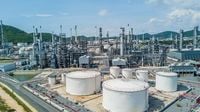On May 6, 2025, crude oil prices began to recover after hitting a four-year low, as geopolitical tensions and economic concerns continued to shape the market landscape. The price of West Texas Intermediate (WTI) crude for June delivery was reported at $58.03 per barrel, reflecting a rise of 1.6 percent. Similarly, Brent crude for July delivery was priced at $61.20 per barrel, also up by 1.6 percent. By the afternoon, gains accelerated to 2.7 percent, marking a significant rebound from the lows seen earlier in the week.
The recent fluctuations in oil prices can be largely attributed to the decisions made by OPEC+ countries, which agreed to increase oil supplies by 411,000 barrels per day for June. This decision came on the heels of a sharp decline in prices, with Brent crude dropping below $60 per barrel for the first time since February 2021. The increase in production has raised concerns about oversupply in the market, especially as major economies like the United States and China grapple with a trade war that threatens to dampen demand for oil.
President Donald Trump, in a recent interview on NBC's "Meet the Press," indicated a willingness to lower tariffs on Chinese goods, which currently stand at a staggering 145 percent. China, in response, has imposed tariffs of 125 percent on American products. Trump stated, "At some point, I’m going to lower them (the tariffs) because otherwise, you could never do business with them (the Chinese), and they really want to do business." This statement reflects a potential shift in U.S.-China relations, which could influence global oil demand.
Amid these developments, China's economic indicators have raised alarms. Factory activity there has been reported as the weakest since 2023, with new export orders plummeting to their lowest level since December 2022, marking the largest drop since the pandemic lockdowns in April 2022. These economic struggles in China have significant implications for global oil demand, as the country is one of the largest consumers of crude oil.
In addition to the geopolitical landscape, the market is also reacting to the internal dynamics of the oil industry. Saudi Aramco, the state-owned oil company of Saudi Arabia, recently announced an increase in crude oil prices for Asian consumers in June. This move comes as the company adjusts to the shifting demands of the global market while navigating the complexities of OPEC+ agreements.
Analysts at Biuro Reflex have expressed skepticism about a quick recovery in oil prices, predicting that Brent crude may average around $68 per barrel this year, with expectations of stabilizing around $70 in subsequent years. They noted that both gasoline and diesel prices are currently lower than they were a year ago and are the cheapest since late 2022. This trend reflects a stabilizing domestic fuel market, even as wholesale prices have ceased their rapid decline.
The overall sentiment in the oil market is cautious, with many players awaiting decisions from the Federal Reserve regarding interest rates and the ongoing negotiations about tariffs with the United States. These factors contribute to the volatility of oil prices, as fears of a global recession loom large and demand growth has not met earlier expectations.
As the market adjusts to these new realities, the interplay of geopolitical tensions, economic indicators, and OPEC+ decisions will continue to shape the trajectory of oil prices in the coming months. Investors and consumers alike will be watching closely to see how these developments unfold, particularly as the summer driving season approaches and demand typically increases.


